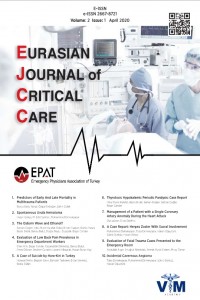Abstract
References
- 1. Gussak I, Bjerregaard P, Egan TM, Chaitman BR: ECG phenomenon called the J wave: history, pathophysiology, and clinical significance. J Electrocardiol 1995;28:49-58.
- 2. Osborn JJ. Experimental hypothermia; respiratory and blood pH changes in relation to cardiac function. Am J Physiol 1953;175:389-98.
- 3. Siniorakis E, Arvanitakis S, Roulia G, Voutas P, Karidis C. Myocardial damage after prolonged accidental hypothermia: a case report. J Med Case Rep. 2009;3:8459.
- 4. Maruyama M, Atarashi H, Ino T, KishidaH. Osborn waves associated with ventricular fibrillation in a patient with vasospastic angina. J Cardiovasc Electrophysiol 2002;13:486-9.
- 5. Randall CB. Disposition of toxic drugs and chemicals in man. 7th ed. Foster City (CA): biomedical Publications; 2004. p.411-13.
- 6. American Heart Association (2014) Alcohol and He¬art Health AHA Recommendation The web site: hhtp//www.heart.org.
- 7. Wijnandts PR., JAP Van der Sloot, WK Lagrand. "Osborn waves in hypothermia. Case report and clinical images." Netherlands journal of critical care 14 (2010):111-112.
Abstract
The Osborn wave which is also known as
the J wave in electrocardiogram (ECG) is most commonly detected in the cases
with hypothermia. Furthermore, this wave may develop as secondary to many
conditions such as hypercalcemia, hypoglycemia, brain damage, ischemic heart
disease. The Osborn wave disappears when the underlying cause is recovered. As
is known, alcohol is a substance made of ethyl alcohol which may cause severe
cardiac problems such as cardiomyopathy, cardiac arrhythmia and cardiac arrest
In the present case report, we wanted to address the association of a typical
Osborn wave with high blood level of alcohol by presenting two cases whom
Osborn wave was detected after cardiac arrest and hypothermia developed
secondary to high alcohol level in the blood; and discuss the association between
Osborn wave and high blood levels of alcohol.
Keywords
References
- 1. Gussak I, Bjerregaard P, Egan TM, Chaitman BR: ECG phenomenon called the J wave: history, pathophysiology, and clinical significance. J Electrocardiol 1995;28:49-58.
- 2. Osborn JJ. Experimental hypothermia; respiratory and blood pH changes in relation to cardiac function. Am J Physiol 1953;175:389-98.
- 3. Siniorakis E, Arvanitakis S, Roulia G, Voutas P, Karidis C. Myocardial damage after prolonged accidental hypothermia: a case report. J Med Case Rep. 2009;3:8459.
- 4. Maruyama M, Atarashi H, Ino T, KishidaH. Osborn waves associated with ventricular fibrillation in a patient with vasospastic angina. J Cardiovasc Electrophysiol 2002;13:486-9.
- 5. Randall CB. Disposition of toxic drugs and chemicals in man. 7th ed. Foster City (CA): biomedical Publications; 2004. p.411-13.
- 6. American Heart Association (2014) Alcohol and He¬art Health AHA Recommendation The web site: hhtp//www.heart.org.
- 7. Wijnandts PR., JAP Van der Sloot, WK Lagrand. "Osborn waves in hypothermia. Case report and clinical images." Netherlands journal of critical care 14 (2010):111-112.
Details
| Primary Language | English |
|---|---|
| Subjects | Intensive Care |
| Journal Section | Case Reports |
| Authors | |
| Publication Date | April 26, 2020 |
| Submission Date | August 27, 2019 |
| Acceptance Date | October 7, 2019 |
| Published in Issue | Year 2020 Volume: 2 Issue: 1 |

